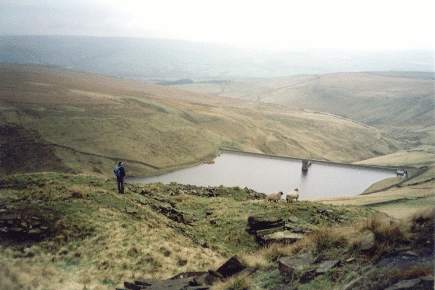PREDICTING RECOVERY IN ACIDIFIED FRESHWATERS BY THE YEAR 2010, AND BEYONDContract EVK1-1999-00087 - RECOVER:2010 Part of the 'Sustainable Management and Quality of Water' Ecosystem Functioning Directorate General Research |
|||||||||
|
Upland Britain - Pennines
Scout Moor Reservoir,
 The South Pennine uplands, in northern England, lie at the centre of the largest industrial area in the UK. Surrounding cities such as Manchester, Sheffield, Bradford and Leeds were at the forefront of the industrial revolution during the 19th Century, and the acute atmospheric pollution that resulted is evident throughout the region in soot contamination of blanket bogs. Although emissions have fallen in recent years,
deposition remains high relative to other acid-sensitive areas of the UK; 1992-94 total non-marine sulphur deposition exceeded 30 kg S/ha/yr throughout the region, with total N deposition in the range 18-30 kg N/ha/yr (among the highest values recorded for either pollutant anywhere in the UK). Freshwater and terrestrial critical loads are severely exceeded throughout the region. The South Pennines consist of a narrow, relatively low-elevation (< 600m) corridor of moorland orientated approximately north-south, with extensive urban areas on either side (Figure 1). The upland area is almost
entirely underlain by acid-sensitive Carboniferous millstone grits, with less sensitive coal measures to the west and east. Deep blanket peats cover much of the upland plateau, grading to ironpan stagnopodzols, stagnohumic gleys and brown earths at lower elevations. Land-use is primarily unimproved rough grazing at higher elevations, with some improved grazing on lower slopes. Afforestation is much less widespread than in other acid-sensitive areas of the UK, limited mainly to small plantations on the southeastern moorland fringe. The 60 sites sampled for this study are all small, headwater
reservoirs, of which the region contains un unsually high number. Most are small earth embankments, constructed during the mid to late nineteenth century. All reservoirs were sampled in April 1998, and catchments were selected to contain less than 25% improved farmland.
The South Pennine uplands, in northern England, lie at the centre of the largest industrial area in the UK. Surrounding cities such as Manchester, Sheffield, Bradford and Leeds were at the forefront of the industrial revolution during the 19th Century, and the acute atmospheric pollution that resulted is evident throughout the region in soot contamination of blanket bogs. Although emissions have fallen in recent years,
deposition remains high relative to other acid-sensitive areas of the UK; 1992-94 total non-marine sulphur deposition exceeded 30 kg S/ha/yr throughout the region, with total N deposition in the range 18-30 kg N/ha/yr (among the highest values recorded for either pollutant anywhere in the UK). Freshwater and terrestrial critical loads are severely exceeded throughout the region. The South Pennines consist of a narrow, relatively low-elevation (< 600m) corridor of moorland orientated approximately north-south, with extensive urban areas on either side (Figure 1). The upland area is almost
entirely underlain by acid-sensitive Carboniferous millstone grits, with less sensitive coal measures to the west and east. Deep blanket peats cover much of the upland plateau, grading to ironpan stagnopodzols, stagnohumic gleys and brown earths at lower elevations. Land-use is primarily unimproved rough grazing at higher elevations, with some improved grazing on lower slopes. Afforestation is much less widespread than in other acid-sensitive areas of the UK, limited mainly to small plantations on the southeastern moorland fringe. The 60 sites sampled for this study are all small, headwater
reservoirs, of which the region contains un unsually high number. Most are small earth embankments, constructed during the mid to late nineteenth century. All reservoirs were sampled in April 1998, and catchments were selected to contain less than 25% improved farmland.
| Figure 1 |

Almost half of all sampled sites had a negative ANC, and a pH below 5.0, with several sites having a pH below 4.0 (Table 1). Sulphate concentrations were extremely high (median 248 meq/l) and a median nitrate concentration in excess of 40 meq/l suggests that freshwaters throughout the region are at an advanced stage of nitrogen saturation. These data have been analysed in detail by Evans et al., (2000). Available long-term data from this region suggest that some degree of pH recovery has occurred since 1980, but this appears to have been slowed by increased leaching of nitrate (Evans and Jenkins, 2000).
Table 1: Summary statistics of the Pennine Resevoirs
|
10th Percentile |
Median |
90th Percentile |
|
|
ANC |
-85 |
13 |
108 |
|
pH |
4.08 |
5.27 |
6.60 |
|
SO4 |
165 |
248 |
353 |
NO3 |
26 |
41 |
77 |
|
Cl |
175 |
243 |
544 |
|
SBC |
285 |
601 |
964 |
|
NH4 |
1.5 |
4.0 |
8.9 |
|
DOC |
2.5 |
4.9 |
7.8 |
All concentrations meq/l except for pH (pH units) and DOC (mg/l).
Photo Gallery

Black Moss Reservoir

Broomhead Reservoir
| Results from Pennines |
| For more information contact: Cev@ceh.ac.uk |
| REGIONS |
References
-
Evans, C.D., Jenkins, A., Wright, R.F. (2000). Surface water acidification in the South Pennines I. Current status and spatial variability. Environmental Pollution 109: (1) 11-20. -
Evans, C.D. and Jenkins, A. (2000). Surface water acidification in the South Pennines II. Temporal trends Evans CD, Jenkins A Environmental Pollution 109: (1) 21-34.





